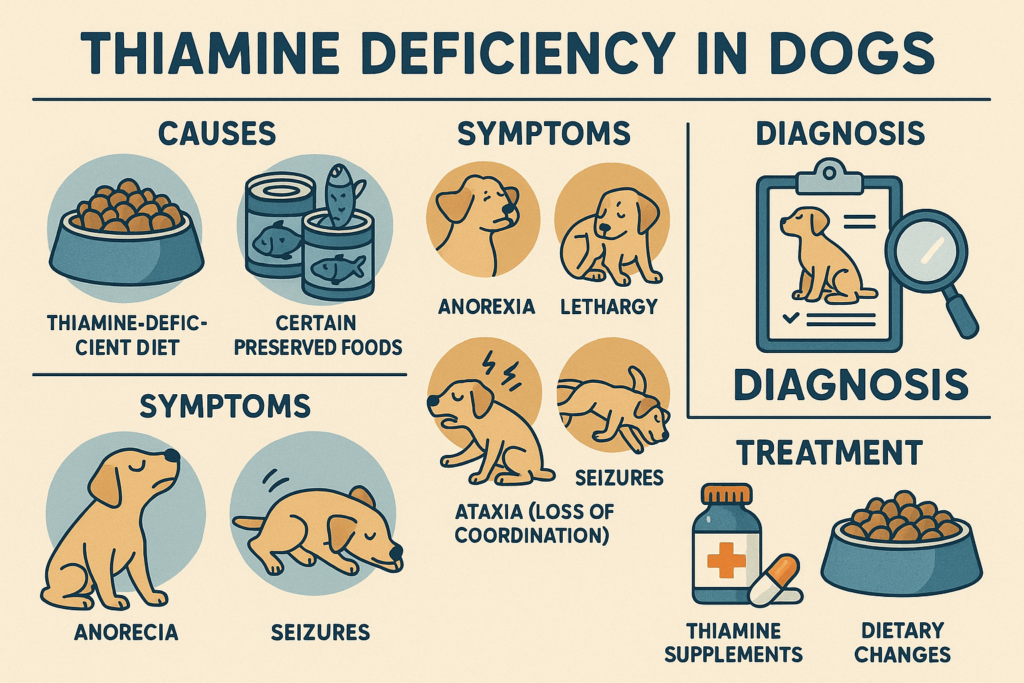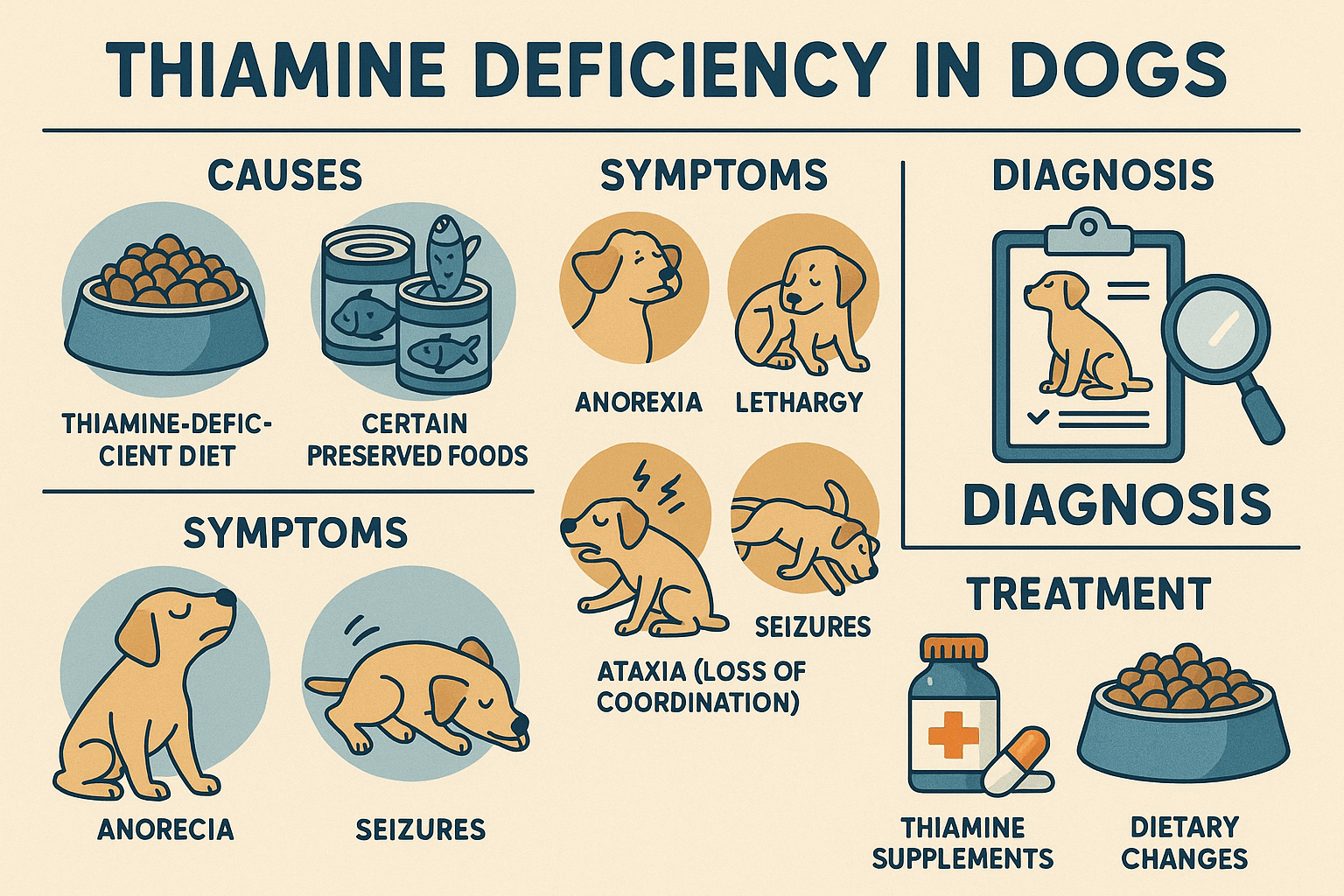Thiamine Deficiency in Dogs: What Every Pet Owner Should Know
Thiamine, also known as vitamin B1, plays a crucial role in your dog’s overall health. It supports essential functions like energy production, nerve function, and metabolism. However, thiamine deficiency in dogs can lead to serious health issues if left untreated. This condition occurs when a dog doesn’t receive enough thiamine in their diet or when factors interfere with its absorption. Understanding the causes, symptoms, and treatment options for thiamine deficiency is vital for ensuring your furry friend stays healthy and happy. In this blog post, we’ll explore everything you need to know about this often-overlooked condition and how to prevent it.
Thiamine is a water-soluble vitamin that plays a crucial role in carbohydrate metabolism.
Carbohydrates are a macronutrient that provide energy and other health benefits. In dogs, they are also the main source of dietary fiber. Dogs are not able to synthesize thiamine. This means that it must be obtained from the diet. Most dogs fed a commercial or store-bought pet food will receive adequate dietary thiamine, and, therefore, are very unlikely to develop thiamine deficiency.
Common Causes of Thiamine Deficiency in Dogs
Thiamine deficiency can arise from various factors, ranging from dietary imbalances to underlying health conditions. Identifying these causes is the first step in prevention and treatment.
Poor-Quality Diets:
Low-quality commercial dog foods may lack sufficient thiamine, especially if they’re improperly stored or processed.Raw Fish Diets:
Certain raw fish contain thiaminase, an enzyme that breaks down thiamine, leading to deficiencies if consumed regularly.Excessive Consumption of Sulfur Dioxide:
Preservatives like sulfur dioxide in some pet foods can interfere with thiamine absorption.Digestive Disorders:
Conditions such as inflammatory bowel disease can impair nutrient absorption, including thiamine.Prolonged Vomiting or Diarrhea:
Chronic gastrointestinal issues can deplete thiamine levels by preventing proper nutrient uptake.
By understanding these potential causes, pet owners can take proactive steps to ensure their dogs receive adequate thiamine through proper nutrition and care.

Symptoms of Thiamine Deficiency in Dogs
Recognizing the signs of thiamine deficiency early is critical for timely intervention. These symptoms often manifest gradually but should not be ignored.
Lethargy and Weakness:
A lack of energy and reluctance to engage in physical activity are common early signs of thiamine deficiency.Loss of Appetite:
Dogs may show disinterest in food or refuse meals altogether due to metabolic imbalances.Neurological Issues:
Symptoms like confusion, disorientation, or difficulty walking can indicate neurological problems caused by low thiamine levels.Seizures or Tremors:
Severe cases of thiamine deficiency can lead to seizures or involuntary muscle tremors.Weight Loss:
Unexplained weight loss despite regular feeding may signal an underlying nutritional deficiency.
If you notice any of these symptoms, consult your veterinarian promptly to rule out thiamine deficiency and other potential health concerns.
Check this guide 👉Rimadyl for Dogs: Best 7 Expert Tips!
Check this guide 👉Navigating Nutrition for Dogs with Giardia: Best 7 Tips!
Check this guide 👉Best Dog Food Toppers: 7 Tips for Happy, Healthy Pups!
Preventing Thiamine Deficiency | Treating Thiamine Deficiency |
|---|---|
Feed high-quality, balanced diets | Administer thiamine supplements under vet guidance |
Avoid excessive raw fish consumption | Provide IV fluids for severe cases |
Store pet food properly to retain nutrients | Monitor recovery progress closely |
Include thiamine-rich foods like pork or liver | Address underlying health conditions |
Regularly check for digestive issues | Adjust diet to meet nutritional needs |
Thiamine-Rich Foods to Include in Your Dog’s Diet
Ensuring your dog’s diet contains adequate thiamine is key to preventing deficiencies. Incorporating these nutrient-rich foods can help maintain optimal health.
Lean Pork:
Pork is one of the richest natural sources of thiamine and can be safely included in moderation.Organ Meats:
Liver, kidney, and heart are excellent sources of thiamine and other essential vitamins.Whole Grains:
Brown rice, oats, and barley provide thiamine along with fiber and other nutrients.Vegetables:
Green peas, spinach, and asparagus are dog-friendly vegetables rich in thiamine.Fortified Dog Foods:
Many high-quality commercial dog foods are fortified with thiamine to meet dietary requirements.
Including these foods in your dog’s meals ensures they receive the necessary thiamine to support their overall well-being.
Steps to Diagnose Thiamine Deficiency in Dogs
Diagnosing thiamine deficiency requires careful evaluation by a veterinarian. Understanding the diagnostic process can help you prepare for a visit to the clinic.
Detailed Medical History:
Your vet will ask about your dog’s diet, eating habits, and recent behavioral changes to identify potential risk factors.Physical Examination:
A thorough check-up helps detect signs like weight loss, weakness, or neurological abnormalities.Blood Tests:
Blood work can measure thiamine levels and assess overall metabolic health.Urinalysis:
Analyzing urine samples provides additional insights into kidney function and nutrient absorption.Response to Treatment:
In some cases, vets may administer thiamine supplements and monitor improvements to confirm the diagnosis.
Early diagnosis and treatment are crucial for reversing the effects of thiamine deficiency and restoring your dog’s health.
Long-Term Effects of Untreated Thiamine Deficiency
Untreated thiamine deficiency can have devastating consequences for your dog’s health. Over time, the lack of this vital nutrient can lead to irreversible damage.
Chronic Neurological Damage:
Prolonged deficiency may result in permanent nerve damage, affecting mobility and coordination.Heart Problems:
Thiamine is essential for heart function; deficiencies can lead to weakened cardiac muscles and heart failure.Cognitive Decline:
Dogs may experience memory loss, confusion, or difficulty learning new commands due to brain dysfunction.Muscle Wasting:
Without adequate thiamine, muscle tissue can deteriorate, leading to weakness and reduced stamina.Increased Risk of Infections:
A compromised immune system makes dogs more susceptible to illnesses and infections.
Addressing thiamine deficiency early is crucial to prevent these long-term effects and preserve your dog’s quality of life.
Tips for Transitioning to a Thiamine-Rich Diet
Switching your dog to a thiamine-rich diet requires careful planning to ensure a smooth transition. Follow these tips to make the process easier.
Gradual Changes:
Introduce new foods slowly over 7-10 days to avoid digestive upset.Monitor for Allergies:
Watch for adverse reactions like itching or vomiting when adding new ingredients.Balance Nutrients:
Ensure the diet includes a variety of nutrients beyond thiamine to meet all dietary needs.Consult Your Vet:
Seek professional advice to tailor the diet to your dog’s age, breed, and health status.Maintain Consistency:
Stick to the new diet consistently to allow your dog’s body to adjust and benefit fully.
A well-planned transition ensures your dog adapts comfortably to their improved diet.
Myths About Thiamine Deficiency in Dogs
Misconceptions about thiamine deficiency can lead to confusion and misinformation. Let’s debunk some common myths surrounding this condition.
Myth: All Commercial Dog Foods Provide Enough Thiamine:
Not all brands are created equal; some may lack sufficient thiamine due to poor formulation or storage.Myth: Thiamine Deficiency Only Occurs in Malnourished Dogs:
Even well-fed dogs can develop deficiencies due to absorption issues or dietary imbalances.Myth: Supplements Alone Can Fix the Problem:
While helpful, supplements should complement—not replace—a balanced diet.Myth: Raw Diets Are Always Safe:
Certain raw foods, like fish, can actually contribute to thiamine deficiency if not prepared correctly.Myth: Thiamine Deficiency Is Rare and Not Serious:
Though uncommon, it can have severe consequences if not addressed promptly.
Understanding the facts helps dispel myths and encourages informed decisions about your dog’s health.
Frequently Asked Questions About Thiamine Deficiency in Dogs
Can thiamine deficiency be fatal?
Yes, if left untreated, severe thiamine deficiency can lead to life-threatening complications like seizures or organ failure.
How quickly does thiamine deficiency develop?
Symptoms can appear within weeks if a dog’s diet lacks sufficient thiamine or if absorption is impaired.
Is thiamine deficiency common in dogs?
While not extremely common, it can occur in dogs fed poor-quality diets or those with specific health conditions.
Can I give my dog thiamine supplements without a vet’s advice?
It’s best to consult your vet before administering supplements to avoid overdosing or masking underlying issues.
Are certain breeds more prone to thiamine deficiency?
No specific breed is predisposed, but dogs with digestive disorders may be at higher risk.
Prioritizing Your Dog’s Nutritional Health
Thiamine deficiency in dogs is a preventable yet potentially serious condition that underscores the importance of proper nutrition. By understanding the causes, recognizing the symptoms, and taking proactive measures, you can safeguard your dog’s health and well-being. Regular veterinary check-ups, a balanced diet, and awareness of potential risk factors are essential tools for every responsible pet owner. Remember, your dog relies on you to provide the care they need—ensuring they receive adequate thiamine is just one way to show your love and commitment to their long, happy life.
Canned Pumpkin for Cat Diarrhea: Best 7 Expert Tips! Natural remedy to firm stools, soothe upset bellies, and support gut health safely.
Can a Cat Give You Scabies? Best 7 Expert Tips! Discover the truth about feline mites, human skin risks, and how to protect yourself—without panic.
Cat Flea vs Human Flea: Best 7 Expert Tips! Discover the truth about bites, species, and how to eliminate infestations for good.
Weird Cat Behaviors: Best 7 Expert Tips! Discover why cats do strange things—and how to understand, not punish, their instincts for a happier home.





